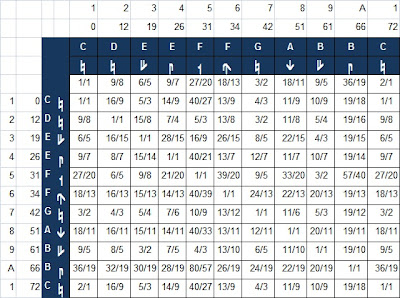This one is final for now. It’s the 14th take through the algorithm.
It uses the subharmonic series to the 15 limit, plus one more (36:19) beyond the 15-limit, and an additional note (27:20) which I added to be harmonious with the 9:5.
18:18 18:16 18:15 18:14 27:20 18:13 18:12 18:11 18:10 36:19 36:18
which can also be written as:
1:1 9:8 6:5 9:7 27:20 18:13 3:2 18:11 9:5 36:19 2:1
From that ten note scale, I pull six notes out at a time and play a set of chords and melodies. Or rather the computer picks out some chords and melodies from an array of choices. There are nine 6-note combinations chosen for this piece, each takes about a minute or two, and then it moves to the next one. Some are sweet, some are sour, some harsh, and a few just plain weird. The subharmonic series has always played tricks on me. The weird ones can be thought of as the sleeping wolves of the undertones. In this piece, they get up and dance.
The instruments are the Ernie Ball Super Slinky Guitar String sample set I made earlier this year, finger pianos, balloon drums, tube drums, trombones, and trumpets.
There are lots of slides and trills. Csound provides for function tables that can be multiplied by a note to make it go up or down at a specific rate to a specific pitch. I generated tables for all the possible combinations of the ratios in the scale, and then through some programming with Excel, the right f table is applied to each note to move to the right next pitch for each of the modes. That’s the feature that can be heard as the slides and shakes of the instruments. Imagine a guitar player sliding up a note and giving it some vibrato when he hits the higher or lower note. Except it can be done for finger piano, trumpet, and strings, not just guitar.
The rhythm is in nine, with stress on the 2 + 3 + 4 beats. The tempo moves around a bit as the algorithm can decide to speed up or slow down by around 15/16ths at random times, slowing way down at the end.
Play it here
or download this link
Subscribe here: 






